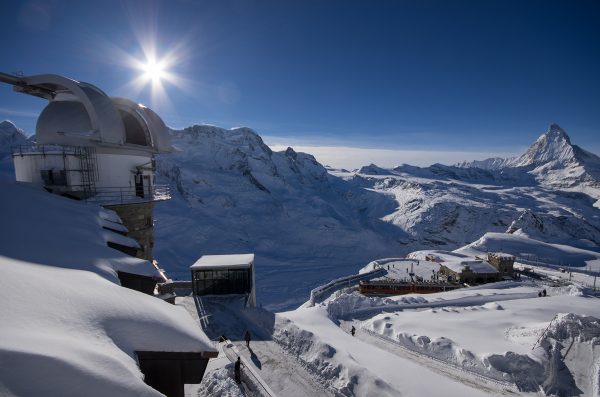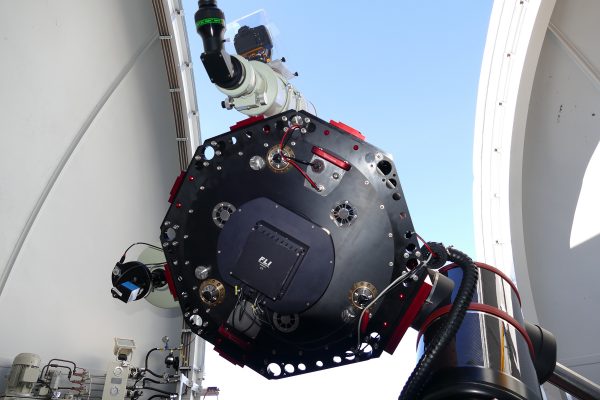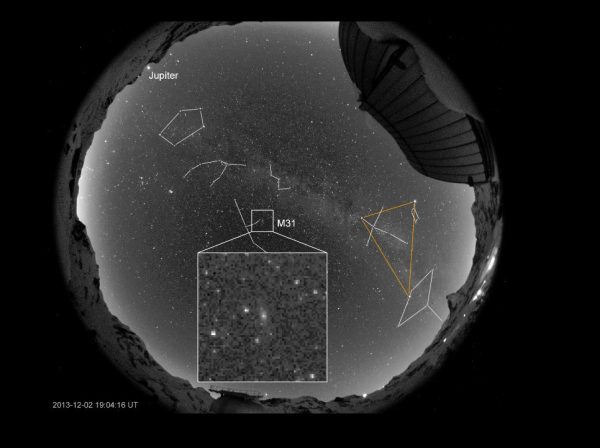The Stellarium Gornergrat officially starts operations for schools

The Center for Space and Habitability at the University of Bern (CSH), the University of Geneva (UNIGE), and their partners built and configured a remote-controllable telescope facility at the Gornergrat. Its primary use is dedicated to education and outreach and its dedicated pedagogical portal just became operational. This way, schools all over Switzerland get access to professional astronomical equipment at the most likely best location for stargazing in Switzerland.

The observatory on Gornergrat. (Photo Stellarium Gornergrat/A.Servonet)
The Gornergrat, with its famous panorama is one of the best locations for astronomical observations in central Europe. In the last 50 years, the Gornergrat served as a location for different international research projects. Today, researcher’s criteria regarding the mirror size, the altitude, and the amount of nights with no clouds for new telescopes often lead to sites in Chile or Hawaii. Therefore, «we, together with astronomers at the University of Geneva, thought about how to best use the Gornergrat in the future», says Dr. Timm-Emanuel Riesen of the Center for Space and Habitability (CSH) of the University of Bern. In collaboration with the foundation High Altitude Research Stations Jungfraujoch & Gornergrat (HFSJG) and the Burgergemeinde Zermatt (the civic community), the idea of a pedagogical telescope, the «Stellarium Gornergrat», was born and further developed. It is a project that is directed at Swiss schools and the broad public.
To realize this project the Burgergemeinde Zermatt provided access to the south dome of the ancient astronomical observatory at the Gornergrat and took over a good part of the costs for the new instruments. The foundation HFSJG updated and revised the installations inside the dome, augmented the internet connection and took care of the logistics. The University of Bern was responsible for the installation of all the instruments and their network interfaces while the University of Geneva developed the web portal, that allows schools to obtain access to observations and pedagogical activities.
«Our goal is to provide teachers with little or no background in astronomy with an attractive way to bring astronomy and space science directly to their classrooms.», declares Sylvia Ekström, astronomer at the department of astronomy at UNIGE. The activities of the portal allow the submission of observation tasks, which the Stellarium executes autonomously at the scheduled time and date, if the weather permits. After completion, the users can directly download their images from the portal. We tried our best to make it as easy as booking a hotel room.

The instruments with the DeepSky telescope in the middle. (Photo Stellarium Gornergrat/Timm Riesen)
Heavens at your service
The main instrument which we call the «DeepSky telescope» is a brand new 60cm mirror telescope built by the Italian company Officina Stellare. The optical performance is very good and the telescope has an outstanding large field of view. With it, extended objects like the Moon, larger galaxies or nebulae can be observed in full without any problems.
A large field of view would be of little to help to observe small objects like planets, comets, and asteroids. To achive this, we use our «Planet-telescope», a nice Takahashi reflector (mirror telescope) with 3 meters focal length and an aperture of 250mm. It is ideal to observe our neighbouring planets, Saturn with its rings, or Jupiter with the great red spot, a huge storm on its surface.
We also have a «Constellation-Camera», a Canon 60Da DLR camera, that was placed in a housing that we developed at the University of Bern to allow full portal use, including setting the zoom factor. With this instrument, complete constellations, asterism, or part of a constellation can be depicted, including the deep sky objects that are hiding (to the naked eye) within. It is a great way to explain to students, where Orion nebula really sits in that constellation.
For guests that are locally present, we also have a telescope with eye pieces that allow observing with the eye. Our «LookThrough» telescope is a Takahashi refractor (lens telescope) with supreme optical qualities.
All these instruments are mounted on a German mount by ASA. The main axis of this buckling column in aligned in parallel to the Earth’s axis, which allows the motors to compensate the Earth’s rotation, which in turn allows the instrument to collect the light over time, without stretching the observed objects to long lines.
Our instrument suite is rounded off by a high sensitive black and white fisheye camera, which can cover the complete sky at once. This «AllSky Camera» provides a new 360 degree panorama of the sky at the Gornergrat every 5 minutes, regardless of weather or time. These images can be downloaded either in the portal, or on our official webpage. In our activities, they are used to illustrate Earth’s rotation, Earth’s orbit around the Sun, and the movement of planets compared to the stars in the background.

360 degree image taken with AllSky camera. (Photo Stellarium Gornergrat)
Our plans to include the teachers
Highly complex systems like the Stellarium Gornergrat are never really done developing. There is always room for improvements and new features. But the time is right now, to allow the schools to use this offer actively and for us to collect experience with a larger user base. The CSH and our partners in Geneva already support the teachers with by offering professional trainings in French and German language. These regular and official courses are advertised on our webpage and through our partnering pedagogical high colleges. These trainings are hands on and the teachers can work through a real activity and will learn how to best use the Stellarium Gornergrat. Our portal currently offers content in German and French, but English and Italian language support is planned for the future. The complexity and difficulty of our activities is organized in four levels A to D, going from 5th grade primary school to secondary level I, secondary level II, and first year students at university level.
More information:
Stellarium Main: https://stellarium-gornergrat.ch/
Portal: https://stellarium-gornergrat.ch/portal/
Local Offers: http://gornergrat-kulm.ch/das-kulmhotel/stellarium-gornergrat/
CSH: http://www.csh.unibe.ch/index_eng.html

